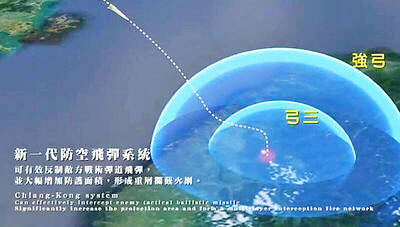The number of ballistic and cruise missiles aimed by China’s Second Artillery Corps at Taiwan has grown from 1,400 last year to more than 1,600 this year, which poses a serious threat to the nation, the Ministry of National Defense (MND) said in its China Military Power Report 2012.
This year’s annual report, which has been delivered to the legislature, emphasizes China’s growing missile threat.
It said the People’s Liberation Army had deployed a small number of advanced Dong Feng-16 (DF-16) missiles to complement the arsenal of DF-11 and DF-15 short-range missiles that has threatened Taiwan over the years. National Security Bureau Director Tsai Der-sheng (蔡得勝) told the legislature in March last year that the Chinese military had completed developing the new DF-16. Photographs in April suggested the deployment of the medium-range missile had begun. Military analysts also believe that the DF-16 may be mobile, which would make interception more difficult.
To increase area-denial, the Second Artillery has deployed DF-21D anti-ship ballistic missiles, the report said, adding that DF-31A ICBMs armed with nuclear warheads and capable of reaching the US and most European countries were deployed to deter other countries from interfering in any conflict in the Taiwan Strait.
The number of ballistic and cruise missiles aimed at Taiwan has increased by about 200 from last year and is now estimated at 1,600, it said, adding that an increasing number were equipped with advanced GPS systems allowing for precision attacks against Taiwan.
Facing an increased threat from Chinese missiles, plans are being made to modernize Taiwan’s air defense systems, the report said.
According to the military budget proposal for next year, the ministry has earmarked funds to modernize and expand its surface-to-air missiles (SAM), with the ministry planning to procure rocket boosters from the US to place on the AIM-120 advanced medium-range air-to-air missile. It also has plans to acquire AGM-65G Maverick missiles, AGM-84L Harpoon missiles and Magic II missiles, as well as the domestically produced Tien Chien II missiles.
The Chungshan Institute of Science and Technology is also to be called upon to modernize parts of the indigenous Tien Kung “Sky Bow” I and II air-defense systems.
The military also plans to send aging MIM23 Hawk medium-range SAMs to the US for efficiency tests, the budget proposal shows.
In addition, the military plans to procure rocket motors from the US to equip its Standard Missile 1, it says.
Although relations across the Taiwan Strait have improved, China has not slowed its military buildup, which is mainly intended to deter the Taiwanese independence movement, the report says.

LIMITS: While China increases military pressure on Taiwan and expands its use of cognitive warfare, it is unwilling to target tech supply chains, the report said US and Taiwan military officials have warned that the Chinese People’s Liberation Army (PLA) could implement a blockade within “a matter of hours” and need only “minimal conversion time” prior to an attack on Taiwan, a report released on Tuesday by the US Senate’s China Economic and Security Review Commission said. “While there is no indication that China is planning an imminent attack, the United States and its allies and partners can no longer assume that a Taiwan contingency is a distant possibility for which they would have ample time to prepare,” it said. The commission made the comments in its annual

DETERMINATION: Beijing’s actions toward Tokyo have drawn international attention, but would likely bolster regional coordination and defense networks, the report said Japanese Prime Minister Sanae Takaichi’s administration is likely to prioritize security reforms and deterrence in the face of recent “hybrid” threats from China, the National Security Bureau (NSB) said. The bureau made the assessment in a written report to the Legislative Yuan ahead of an oral report and questions-and-answers session at the legislature’s Foreign Affairs and National Defense Committee tomorrow. The key points of Japan’s security reforms would be to reinforce security cooperation with the US, including enhancing defense deployment in the first island chain, pushing forward the integrated command and operations of the Japan Self-Defense Forces and US Forces Japan, as

‘TROUBLEMAKER’: Most countries believe that it is China — rather than Taiwan — that is undermining regional peace and stability with its coercive tactics, the president said China should restrain itself and refrain from being a troublemaker that sabotages peace and stability in the Indo-Pacific region, President William Lai (賴清德) said yesterday. Lai made the remarks after China Coast Guard vessels sailed into disputed waters off the Senkaku Islands — known as the Diaoyutai Islands (釣魚台) in Taiwan — following a remark Japanese Prime Minister Sanae Takaichi made regarding Taiwan. Takaichi during a parliamentary session on Nov. 7 said that a “Taiwan contingency” involving a Chinese naval blockade could qualify as a “survival-threatening situation” for Japan, and trigger Tokyo’s deployment of its military for defense. Asked about the escalating tensions

INTERCEPTION: The 30km test ceiling shows that the CSIST is capable of producing missiles that could stop inbound missiles as they re-enter the atmosphere Recent missile tests by the Chungshan Institute of Science and Technology (CSIST) show that Taiwan’s missiles are capable of intercepting ballistic missiles as they re-enter the atmosphere and pose a significant deterrent to Chinese missile threats, former Hsiung Feng III missile development project chief engineer Chang Cheng (張誠) said yesterday. The military-affiliated institute has been conducting missile tests, believed to be related to Project Chiang Kung (強弓) at Pingtung County’s Jiupeng Military Base, with many tests deviating from past practices of setting restriction zones at “unlimited” and instead clearly stating a 30.48km range, Chang said. “Unlimited” restrictions zones for missile tests is